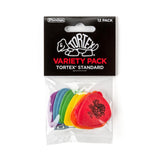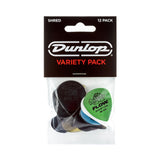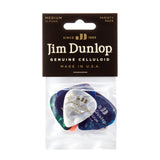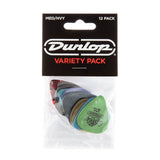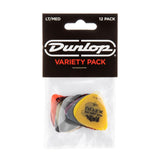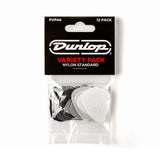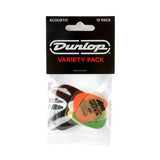Following on from our previous Tone Talk article around Capacitors, this week we will be delving deeper into the inner workings of Tone Pots and their effect on your guitar tone. Arguably one of the least understood objects in terms of electric guitar components, Pots, or to give them their full name, Potentiometers, can vastly improve the sound of your instrument whilst costing very little.
What is a Potentiometer?
A Potentiometer allows you to progressively change the way electrical current flows mechanically, by adjusting the ohmic resistance value. A less science-y way of thinking about this is to imagine a light switch dimmer, the more you turn, the more signal flows through and the brighter it becomes. Much in the same way the light bulb gets brighter in our light switch dimmer example, your guitar tone also gets brighter the more you turn the volume knob on your guitar, with less of the signal being sent to the ground. In terms of volume this is easy to imagine, the more you turn the more volume you get, however your tone knobs are a slightly different kettle of fish.

Guitar Volume and Tone Pots are exactly the same in terms of construction, however a Tone Pot works differently because you attach a Capacitor to it. By placing a Capacitor in between the pot and the ground you transform the way it acts from a straight on/off switch to a simple EQ. With a Capacitor attached instead of the signal going entirely to the ground, only a portion of it is removed. The Capacitor only lets high frequencies pass through, which is why you get a change in sound when you roll your tone knobs on or off.
Tone Pots - The Variations
Tone Pots come in various forms and guises so it’s important to make sure you’re picking the right ones for your needs and for your instrument. There are several options to pick from and all of which will have different effects depending on how they combine with the pickups you’re using, as well as the Capacitors.
Mini Pots v Full Size
For the most part Mini Pots are considered inferior to full size Tone Pots. This is because Mini Pots tend to be used in beginner guitars due to their low cost, which has resulted in them getting a bit of a bad reputation. However much like the debate between types of Capacitor, there’s not much evidence to say there’s any difference between the two in terms of tone. Tonally speaking, we’ve not been able to tell the difference between an Alpha Mini Pot and an Alpha Pot of the full size variety.

That said, one complaint we regularly hear from luthiers and guitar techs is that Mini Pots don’t last as long as a full size Tone Pot, likely due to the cheaper materials used in the construction of a Mini Pot. It’s important to note that many of your guitar pedals, amplifiers, and mixers make good use of use Mini Pots. However your guitar knobs are used far more often than those on your other bits of gear, they are more subject to wear and tear and thus, more likely to fail over time.
500k v 250k Tone Pots
If you’ve looked into Tone Pots previously you’ll have noticed that they tend to either be 250k or 500k. It’s a general rule of thumb that Humbuckers should be paired with 500k pots, whilst single-coils have their perfect match with 250k pots. This is not a hard and fast rule and as with all guitar modifications, really dependent upon what sounds good to your own ear. For a beginner guitar builder however, we'd recommend you stick to this rule until you’re ready to start experimenting with combinations of Tone Pot and Tone Cap values. If you have a HSS Strat, then it's recommended that you fit 500k Pots.
500k Pots
500k pots work best with humbuckers because of their higher resistance. A higher resistance means a brighter sound, so pairing them with the more typically ‘dark’ sounding humbuckers helps your pickups really shine, preventing them from sounding ‘muddy’. This is why you’d typically find 500k pots in humbucker equipped guitars from manufacturers such as Gibson, Epiphone, PRS and Ibanez.
250k Pots
250k pots have a lower resistance thus send more high frequencies to the ground. This makes them great for taming overly bright and harsh sounding single coil pickups. Nobody likes a shrill or piercing single-coil which is why you’ll find 250k pots on the all the purveyors of single coil sound such as Fender, Squier, and Danelectro.

Other Types
More rare than the usual suspects above, you also get 300k Pots which are used predominantly by Gibson, serving as a ‘halfway’ point between 250k and 500k pots. They’re used to deliver a warmer, more vintage sound that you’d have gotten in classic guitars where QC wasn’t such a big deal and Tone Pot values would vary from guitar to guitar.
You can also get 1 Meg pots which are incredibly bright and you’d typically find these on Telecasters used as a bass roll-off or on Jazzmasters which need a brighter sound for their specific pickup type. Finally there is the even rarer 25k Tone Pot, which you’ll most likely find on instruments that have active electronics such as EMG pickups.
Linear vs Audio Taper
We get asked the difference between Linear and Audio Taper a lot and although the science behind it is pretty confusing, it’s actually quite simple to differentiate between the two in terms of guitar tone. Let’s break them down:
Linear Pots
A Linear Pot is, as you can imagine from the name, linear. It will affect your guitar signal in as straight line, so once you’re at the 50% mark of your knob, you will be getting 50% of the signal. However, this is not the way the human ear perceives sound, so what actually happens is that in the last 25% of the turn before you move to full volume, you will actually hear 90% of the signal change. This is called the Weber-Fechner law, and applies to all sense stimuli, including your taste, touch, sight, and smell alongside your hearing. So if you find that there’s little difference going from 0 to 3 on your Volume or Tone Knobs then the same from 8 to 10, chances are you have a Linear Pot installed.
Audio Taper or Logarithmic
Enter Audio Taper Pots. Instead of allowing signal through in a straight line, an Audio Taper Pot does it with a curve in the middle, giving a more perceivable change in sound over the course of a full turn of your guitar knob. A lot of guitarists prefer having control in a smaller portion of the guitar knobs as it is more useful in a live scenario, giving easier control for volume swells as well as the speed of change when riding the volume to go from clean to dirty or vice versa.

Despite this difference its really down to your personal preference which you choose, some guitarists prefer Linear and some prefer Audio Taper, so it’s really up to you to decide which you’d like. A lot of manufacturers have an Audio Taper Pot for the Volume Knob and Linear Pots for the Tone Knobs but this isn't a standard, Fender tend to have Audio Taper on everything for example.
Split Shaft Vs Solid Shaft
But wait, there's more! Another question we’re asked frequently is whether you need Split Shafts or Solid Shafts. Simply put if you have plastic knobs then you will likely need a Split Shaft, as commonly found on Fender Strats. The Split Shaft design allows you to slide a plastic knob on top without having to attach it with a screw.

If you have metal knobs then you’ll need a solid shaft, as there is a small screw in the majority of metal knobs that requires tightening onto the post. It’s for this reason you can’t use metal knobs with split shaft pots, because by tightening the screw you can potentially break the shaft, resulting in a wasted pot! So before you change your guitar knobs or your pots, make sure you’re replacing like for like!
Push Pull Pots
We're almost done now I promise! The Push Pull Pot, particularly in the modern era of guitar has become one of those must have electric guitar modifications, adding further versatility to the already Swiss Army Knife-esque electric guitar armoury. They can do various functions but are most commonly used to split humbuckers (known as coil splitting or coil tapping) as well as reversing the phase of pickups which can give you some amazing tonal options.

The Push Pull Pot is essentially a regular tone pot on top of a switch, which gives you the ability to pull up or push down your tone or volume knob. You can wire them to do an endless series of actions including partial coil splitting, engaging a treble bleed circuit, and even switching between multiple tone caps on one tone knob.
Guitar Potentiometers
Now that we’ve exhausted the endless varieties of Tone Pots you can get your hands on, we can start talking about the different brands of Pots we stock here at Northwest Guitars. Tone Pots are such a great upgrade for your guitar because they’re cheap and easy to install. All you need is a bit of experience with a soldering iron, some safety glasses, wire cutters, and a cameraphone to keep track of your wiring and you’re away!
Alpha Pots
The Alpha Potentiometer is the most commonly found guitar pot in the world, they’re in pretty much everything! You’ve probably got a set somewhere in your collection at home and this is mainly due to the fact that they’re well made and inexpensive. Alpha Pots are also lauded for their dampened rotational control, which gives you a really nice, smooth feel when you turn.
Check out all our Alpha Pots here.
CTS Pots
CTS pots are typically used by higher end guitar builders and techs but this is not due to any difference in tone. The main reason cited for using CTS pots is that they will last longer due to a more sturdy build construction and for that reason, you’ll often find them used in USA-made guitars and guitar gear.
Check out our CTS Pots here.
Seymour Duncan Pots
Seymour Duncan make amazing pickups, so it makes sense that their pots are equally high quality. Crafted to Seymour Duncan's exacting specification by Bourns Pots, these pots have a smooth and responsive feel to them and are built from high quality components, so you can expect that they will stand the test of time!
Have a look at our Seymour Duncan Pots here.
Conclusion
If you’re unhappy with the way your guitar sounds, changing the pots can be a quick and cheap upgrade to help you get closer to the sound in your head. Taking into account the fact that the signal from your pickup passes through your pots, making this simple swap can really help ensure you’re getting the best tone possible out of your guitar. However before you change out your Tone Pots, make sure you check out our article on Capacitors to ensure you have the full picture on how Tone Pots and Tone Caps interact with one another.
Shop all Tone Pots here.
Learn More
Guitar Pots work hand in hand with Capacitors so it's worth reading up on both for a more complete understanding.
Our Seymour Duncan Pickup Guide gives you the low down on these best sellers.
A Note On Track Material
Our customer Chris sent in this very interesting addendum on track material, offering some more information on the subject of tone pots. Thanks Chris!
"The track material can make a big difference. The track is nearly a full circle (270 degrees is normal) of resistive material. The control shaft moves a contact round the track, this then passes the audio signal on to the guitar jack socket. The contact is called the wiper."
"Early pots used carbon for their tracks. It is still used in none-critical applications. Nowadays a lot of pots use conductive plastic or ceramic ('Cermet') materials, which are much better in many respects. I think the most important one is noise. If you fit a pot that has a carbon track to a guitar it won't be long before it starts to wear, especially if the guitarist frequently adjusts it. This wear manifests itself as 'noise', which you have probably heard before, many times. When you rotate the pot it sounds like a sort of scratchy noise from the speaker, sometimes with harsh clicks and rattles that make you fear for your EL34's. The spec for a Bourns carbon pot shows 100mV of noise being generated when rotating a typical carbon pot, which is comparable to the output from some guitar pickups."
"'Cermet' and conductive plastic tracks last a lot longer before becoming noisy, but even they will go that way eventually. Only to be expected, after all, the wiper is a moving part rotating around a fixed part. A carbon pot can become noisy even if it is never moved, although that doesn't happen very often."
"So, it all boils down to getting what you pay for, Carbon is cheap, about a quid for a pot. Ceramic or plastic is more expensive, maybe up to a fiver. But if you are auditioning to be a member of Pink Floyd or ELO you don't want to be let down by cheap pots!"
"You can get inside the pots shown in your photos quite easily. Find a duff pot that you were about to throw away and lift the four tabs around the top of the main body using a screwdriver or penknife (careful now). Once you've lifted them a little bit you will be able to use a small pair of pliers. The shaft and associated parts will then come out of the main body, revealing the track and the wiper." - Christopher F. Beesley.













